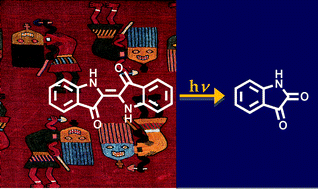A photochemical study on the blue dyeindigo: from solution to ancient Andean textiles
Abstract
The degradation of

* Corresponding authors
a
Department of Conservation and Restoration, New University Lisbon, Campus da Caparica, Portugal
E-mail:
mjm@dq.fct.unl.pt
Fax: (00351) 21 294 8322
Tel: (00351) 21 294 8322
b REQUIMTE-CQFB and Faculty of Sciences and Technology of the New University Lisbon, Campus da Caparica, Portugal
c Department of Chemistry, University of Coimbra, Coimbra, Portugal
The degradation of

 Please wait while we load your content...
Something went wrong. Try again?
Please wait while we load your content...
Something went wrong. Try again?
M. M. Sousa, C. Miguel, I. Rodrigues, A. J. Parola, F. Pina, J. S. Seixas de Melo and M. J. Melo, Photochem. Photobiol. Sci., 2008, 7, 1353 DOI: 10.1039/B809578G
To request permission to reproduce material from this article, please go to the Copyright Clearance Center request page.
If you are an author contributing to an RSC publication, you do not need to request permission provided correct acknowledgement is given.
If you are the author of this article, you do not need to request permission to reproduce figures and diagrams provided correct acknowledgement is given. If you want to reproduce the whole article in a third-party publication (excluding your thesis/dissertation for which permission is not required) please go to the Copyright Clearance Center request page.
Read more about how to correctly acknowledge RSC content.
 Fetching data from CrossRef.
Fetching data from CrossRef.
This may take some time to load.
Loading related content
